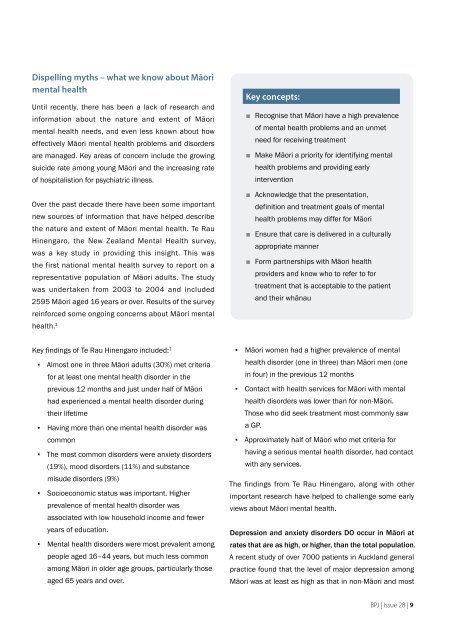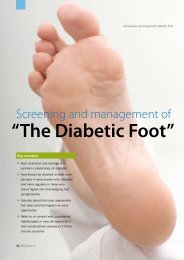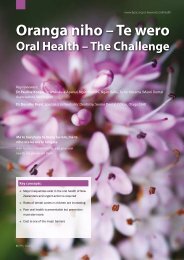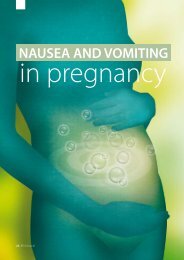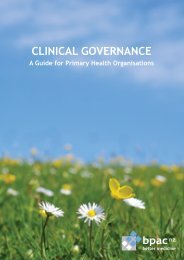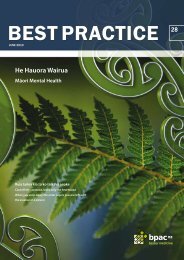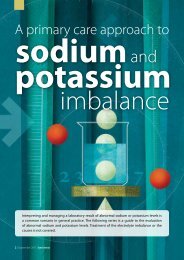Dispelling myths – what we know about Māori<strong>me</strong>ntal healthUntil recently, there has been a lack of research andinformation about the nature and ex<strong>te</strong>nt of Māori<strong>me</strong>ntal health needs, and even less known about howeffectively Māori <strong>me</strong>ntal health problems and disordersare managed. Key areas of concern include the growingsuicide ra<strong>te</strong> among young Māori and the increasing ra<strong>te</strong>of hospitalistion for psychiatric illness.Over the past decade there have been so<strong>me</strong> importantnew sources of information that have helped describethe nature and ex<strong>te</strong>nt of Māori <strong>me</strong>ntal health. <strong>Te</strong> RauHinengaro, the New Zealand Mental Health survey,was a key study in providing this insight. This wasthe first national <strong>me</strong>ntal health survey to report on arepresentative population of Māori adults. The studywas undertaken from 2003 to 2004 and included2595 Māori aged 16 years or over. Results of the surveyreinforced so<strong>me</strong> ongoing concerns about Māori <strong>me</strong>ntalhealth. 1Key concepts:■■ Recognise that Māori have a high prevalenceof <strong>me</strong>ntal health problems and an un<strong>me</strong>tneed for receiving treat<strong>me</strong>nt■■ Make Māori a priority for identifying <strong>me</strong>ntalhealth problems and providing earlyin<strong>te</strong>rvention■■ Acknowledge that the presentation,definition and treat<strong>me</strong>nt goals of <strong>me</strong>ntalhealth problems may differ for Māori■■ Ensure that care is delivered in a culturallyappropria<strong>te</strong> manner■■ Form partnerships with Māori healthproviders and know who to refer to fortreat<strong>me</strong>nt that is acceptable to the patientand their whānauKey findings of <strong>Te</strong> Rau Hinengaro included: 1▪▪ Almost one in three Māori adults (30%) <strong>me</strong>t cri<strong>te</strong>riafor at least one <strong>me</strong>ntal health disorder in theprevious 12 months and just under half of Māorihad experienced a <strong>me</strong>ntal health disorder duringtheir lifeti<strong>me</strong>▪▪ Having more than one <strong>me</strong>ntal health disorder wascommon▪▪ The most common disorders were anxiety disorders(19%), mood disorders (11%) and substancemisude disorders (9%)▪▪ Socioeconomic status was important. Higherprevalence of <strong>me</strong>ntal health disorder wasassocia<strong>te</strong>d with low household inco<strong>me</strong> and feweryears of education.▪▪ Mental health disorders were most prevalent amongpeople aged 16–44 years, but much less commonamong Māori in older age groups, particularly thoseaged 65 years and over.▪▪ Māori wo<strong>me</strong>n had a higher prevalence of <strong>me</strong>ntalhealth disorder (one in three) than Māori <strong>me</strong>n (onein four) in the previous 12 months▪▪ Contact with health services for Māori with <strong>me</strong>ntalhealth disorders was lower than for non-Māori.Those who did seek treat<strong>me</strong>nt most commonly sawa GP.▪▪ Approxima<strong>te</strong>ly half of Māori who <strong>me</strong>t cri<strong>te</strong>ria forhaving a serious <strong>me</strong>ntal health disorder, had contactwith any services.The findings from <strong>Te</strong> Rau Hinengaro, along with otherimportant research have helped to challenge so<strong>me</strong> earlyviews about Māori <strong>me</strong>ntal health.Depression and anxiety disorders DO occur in Māori atra<strong>te</strong>s that are as high, or higher, than the total population.A recent study of over 7000 patients in Auckland generalpractice found that the level of major depression amongMāori was at least as high as that in non-Māori and mostBPJ | Issue 28 | 9
likely to be higher, particularly for Māori wo<strong>me</strong>n. 2 Theseresults support the findings of <strong>Te</strong> Rau Hinengaro and otherstudies. It is no<strong>te</strong>d that when age and socio-economicfactors are taken into account, differences between ra<strong>te</strong>sof depression among Māori and non-Māori are reduced.Māori from all regions of New Zealand DO experiencesimilar ra<strong>te</strong>s of <strong>me</strong>ntal health problems. Results of <strong>Te</strong>Rau Hinengaro indica<strong>te</strong>d that there was no significantdifference in the prevalence of <strong>me</strong>ntal health disordersbetween regions of New Zealand, including both urbanand rural areas. 1There is NO evidence that Māori are geneticallypredisposed to <strong>me</strong>ntal disorder. Research highlightssocial, economic, environ<strong>me</strong>ntal and other influences ascontributing towards disparities in ra<strong>te</strong>s of <strong>me</strong>ntal healthdisorders, rather than genetic factors.There is NO evidence that the high ra<strong>te</strong>s of hospitalisationfor <strong>me</strong>ntal health disorders among Māori are due topoor compliance with <strong>me</strong>dication. No research has beenundertaken that proves Māori to be less compliant with<strong>me</strong>dicines than non-Māori.Although socioeconomic status is an importantcontributor to <strong>me</strong>ntal health problems among Māori, itis NOT the only contributing factor. <strong>Te</strong> Rau Hinengaroidentified that 40% of Māori in the lowest householdinco<strong>me</strong> quartile had a <strong>me</strong>ntal health disorder in theprevious twelve months. However one in six Māori in thehighest inco<strong>me</strong> quartile also experienced a <strong>me</strong>ntal healthdisorder. Socioeconomic de<strong>te</strong>rminants do contribu<strong>te</strong> toethnic differences in <strong>me</strong>ntal health disorders, but do no<strong>te</strong>xplain all differences. Af<strong>te</strong>r adjusting for socioeconomicstatus, the prevalence of substance misuse and otherserious <strong>me</strong>ntal health disorders was still higher inMāori. 1Messages for primary careThere is an un<strong>me</strong>t need for <strong>me</strong>ntal health care in Māori.It is of concern that research indica<strong>te</strong>s that half of Māoriwith a serious <strong>me</strong>ntal health disorder had no contact withhealthcare services. 1 The high ra<strong>te</strong>s of suicidal behaviour,among young Māori males in particular, 3 indica<strong>te</strong> theimportance of exploring <strong>me</strong>ntal health issues with thisgroup.Mental health problems affect Māori in every region ofNew Zealand, both rural and urban. Māori experiencethe sa<strong>me</strong> range of <strong>me</strong>ntal health problems as all NewZealanders. Mental health problems are of<strong>te</strong>n silent, sothe challenge is to find ways in which to communica<strong>te</strong>with Māori patients, be aware of the relationship betweenphysical and <strong>me</strong>ntal health, be open to al<strong>te</strong>rnative waysof expressing <strong>me</strong>ntal health, form partnerships with Māori<strong>me</strong>ntal health service providers and support Māori healthinitiatives.Practical <strong>me</strong>asures for managing <strong>me</strong>ntalhealth problems in MāoriThe Ministry of Health Māori Mental Health and AddictionNational Stra<strong>te</strong>gic Fra<strong>me</strong>work – <strong>Te</strong> Puāwaiwhero, outlinesactions that can be taken to maximise positive outco<strong>me</strong>sfor Māori with <strong>me</strong>ntal health problems. Applying thisfra<strong>me</strong>work to a primary care setting, the following pointsmay be considered: 4▪▪▪▪▪▪Imple<strong>me</strong>nt practice initiatives that recognise andrespond to whānauPlan and deliver effective, responsive and culturallyrelevant careDevelop effective partnerships with <strong>me</strong>ntal healthand addiction services, especially Māori healthservice providersEating disorders DO affect Māori. There was a verylow prevalence overall for eating disorders in <strong>Te</strong> RauHinengaro. However, the highest prevalence of eatingdisorders, particularly bulimia, was in Māori. 1The ultima<strong>te</strong> goal for primary health care providers iseffective communication with Māori, in order to identify andprovide early in<strong>te</strong>rvention for <strong>me</strong>ntal health problems.10 | BPJ | Issue 28


